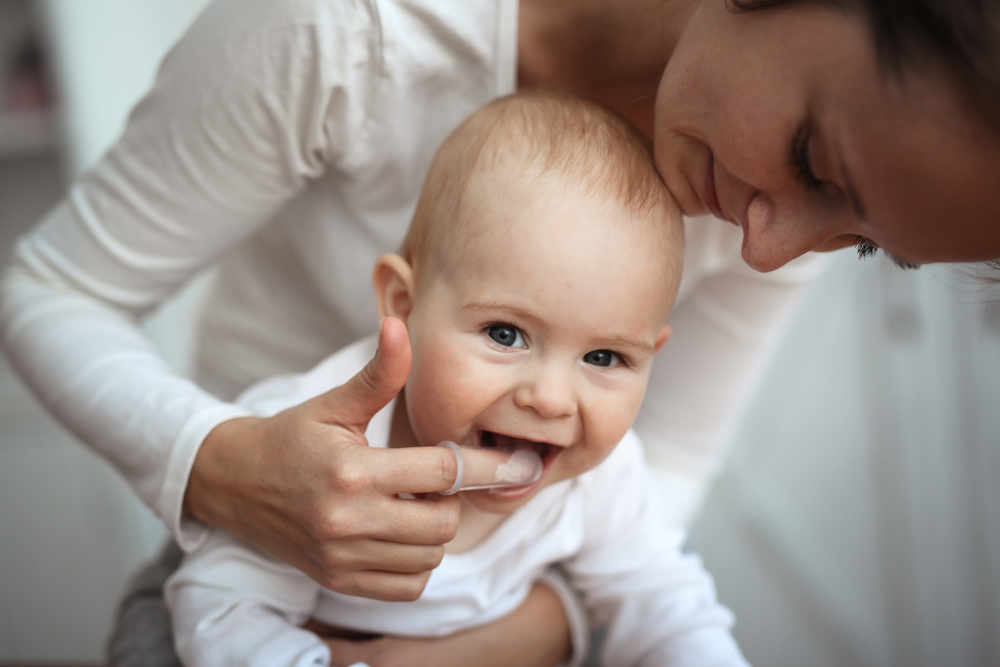
How to Brush Your Newborn’s Gums
Even before your baby’s first tooth appears, it’s important to care for their mouth. A clean mouth helps set up a healthy start for their teeth, which begin forming long before they come in.
By making gum care part of your daily routine, you can lower the chances of problems like early cavities and discomfort. Many parents don’t realize how early oral care should begin, but it starts well before the first visit to the dentist.
It’s Important to Brush Your Newborn’s Gums
Cleaning your baby’s gums helps remove milk residue and bacteria that can build up after feeding. Even though gums don’t have teeth yet, they still collect leftover sugars and particles that feed bacteria. These bacteria can eventually lead to gum irritation or make it easier for cavities to form once teeth begin coming in. Starting early helps your baby get used to the feeling of mouth care, which can make brushing and dentist visits easier later.
Gum cleaning also helps you check your baby’s mouth regularly. You’ll be able to notice any changes—such as swelling or white patches—that you can then bring up with your healthcare provider. By gently caring for their gums, you create a calm and familiar routine that supports your baby’s comfort and health.
How to Clean Your Newborn’s Gums
You don’t need any special tools or products to clean your baby’s gums—just clean hands and a soft, damp cloth. It’s a quick and simple process that you can do once or twice a day, often after the first or last feeding.
Follow these steps to clean your newborn’s gums:
- Wash your hands with soap and warm water.
- Use a soft, clean cloth or a piece of gauze soaked in lukewarm water. Wring it out so it’s damp but not dripping.
- Gently wrap the cloth around your index finger.
- Lay your baby in a comfortable position, either on your lap or a safe flat surface where you can support their head.
- Gently open your baby’s mouth and rub the cloth along the upper and lower gums using small, circular motions.
- Take your time and talk softly to keep your baby calm.
- When you’re done, rinse out the cloth and wash your hands again.
If your baby resists at first, that’s normal. Over time, they’ll get used to the routine. Some babies even enjoy the gentle massage on their gums.
When Should You Switch to Brushing?
Once the first tooth appears, it’s time to switch from cloth cleaning to using a small toothbrush. The Canadian Dental Association recommends starting with a soft-bristled toothbrush made for infants. You don’t need toothpaste right away—a wet toothbrush is enough to clean the new tooth.
As more teeth come in, you can add a rice-sized smear of fluoride toothpaste. Use only a small amount to limit swallowing, and always brush with your child so you can guide the process and make sure the teeth are being cleaned properly.
When Can Your Child Brush on Their Own?
Children can start brushing on their own once they have enough hand control to do it properly. A good way to check is to see if they can tie their own shoelaces. If not, they probably still need help brushing and flossing. Most kids need support with brushing until they are at least six or seven years old.
Until then, you should do the brushing for them or supervise closely. This helps make sure their teeth are cleaned properly and teaches them the right habits. Let them try brushing first, then you can finish the job. This approach builds confidence while still protecting their teeth.
See also: How to Know If Your Child Has Cavities
It’s Important to Visit the Dentist Regularly
Bringing your child to the dentist by their first birthday is recommended by both Canadian and American dental associations. These early visits help spot any problems with gum or tooth development and give you a chance to ask questions. Regular checkups, usually every six months, help your child stay comfortable with dental care and make it part of their normal routine.
If your child is nervous about the dentist, more frequent visits can help. Some children benefit from monthly or quarterly check-ins just to build familiarity. Many pediatric dentists offer welcoming spaces with toys and decorations to keep visits fun and relaxed.
See also: How Often Should You Take Your Child to the Dentist
Book a Pediatric Dental Checkup Today
If you have questions about your child’s oral health or you’re unsure when to start dental visits, Kids Dental Group can help. Our team specializes in caring for infants, toddlers, and young children in a welcoming, family-friendly environment. We know that early dental care builds confidence and comfort, both for your child and for you.
Whether you’re just starting to clean your newborn’s gums or your baby’s first tooth has come in, we’re here to guide you through each step. From checkups to treatment plans tailored to young children, our dentists and hygienists focus on gentle, supportive care that fits your child’s stage of development.
You can book an appointment online or call one of our locations directly. If something doesn’t look right, or if you just want to make sure everything is on track, it’s a good time to get a professional opinion. We’ll help you understand what to expect and how to care for your child’s smile as they grow.
